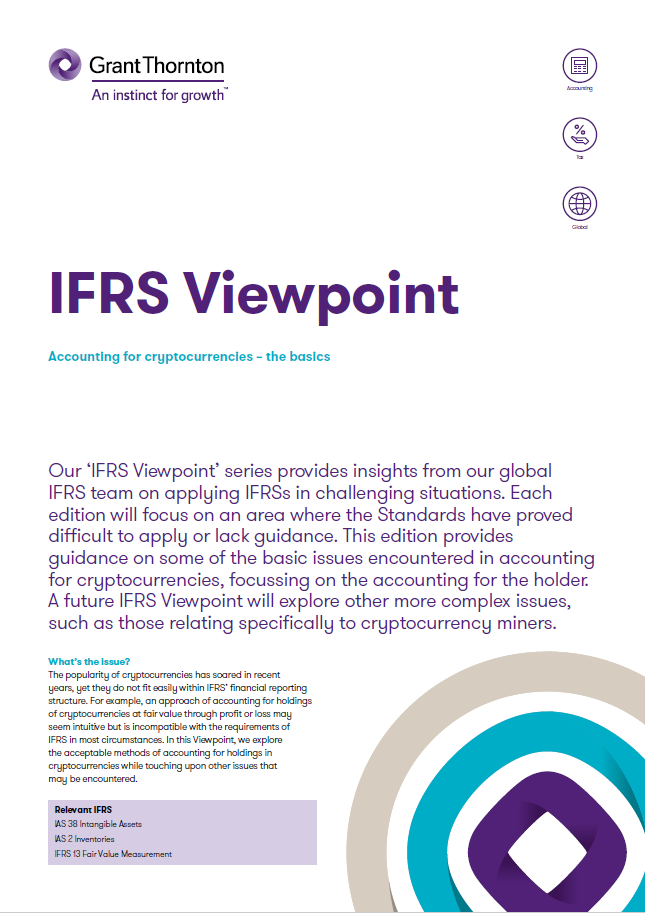-
Accounting Advisory
Our accounting advisory team help businesses meet their complex financial reporting requirements. The team can support in applying new financial reporting standards, IFRS/ US GAAP conversions, financial statement preparation, consolidation and more.
-
Payroll
Our team can handle your payroll processing needs to help you reduce cost and saves time so that you can focus on your core competencies
-
Managed accounting and bookkeeping
Outsourcing the financial reporting function is a growing trend among middle market and startup companies, as it provides a cost-effective way to improve the finance and accounting function. Our team can help with financial statement preparation, consolidation and technical on-call advisory.
-
Accounting Advisory
Our team helps companies keep up with changes to international and domestic financial reporting standards so that they have the right accounting policies and operating models to prevent unexpected surprises.
-
Crypto Accounting Advisory Service
Our team can help you explore appropriate accounting treatment for accounting for holdings in cryptocurrencies, issuance of cryptocurrencies and other crypto/blockchain related accounting issues.
-
ESG Reporting and Accounting
As part of our ESG and Sustainability Services, our team will work with you on various aspects of ESG accounting and ESG reporting so that your business can be pursue a sustainable future.
-
Expected Credit Loss
Our team of ECL modelling specialists combine help clients implement provisioning methodology and processes which are right for them.
-
Finance Transformation
Our Finance Transformation services are designed to challenge the status quo and enable your finance team to play a more strategic role in the organisation.
-
Managed Accounting and Bookkeeping Services
Outsourcing the financial reporting function is a growing trend among middle market and startup companies, as it provides a cost-effective way to improve the finance and accounting function. Our team can help with financial statement preparation, consolidation and technical on-call advisory.
-
Business Tax Advisory
Our business tax team can help you navigate the international tax landscape, grow through mergers and acquisitions, or plan an exit strategy.
-
Corporate Finance
Our corporate finance team helps companies with capital raising, mergers and acquisitions, private equity, strategic joint ventures, special situations and more.
-
Financial Due Diligence
From exploring the strategic options available to businesses and shareholders through to advising and project managing the chosen solution, our team provide a truly integrated offering
-
Valuations
Our valuation specialists blend technical expertise with a pragmatic outlook to deliver support in financial reporting, transactions, restructuring, and disputes.

-
Sustainability with the ARC framework
Backed by the CTC Grant, businesses can tap on the ARC Framework to gain access to sustainability internally, transform business processes, redefine job roles for workers, and enhance productivity. Companies can leverage this grant to drive workforce and enterprise transformation.

-
Business Tax Advisory
Our business tax team can help you navigate the international tax landscape, grow through mergers and acquisitions, or plan an exit strategy.
-
Corporate Tax Compliance
Our corporate tax teams prepare corporate tax files and ruling requests, support you with deferrals, accounting procedures and realise tax benefits.
-
Tax Governance
Our Tax Governance Services are designed to assist organisations in establishing effective tax governance practices, enabling them to navigate the intricate tax environment with confidence.
-
Goods and Services Tax
Our GST team supports organisations throughout the entire business life-cycle. We can help with GST registration, compliance, risk management, scheme renewals, transaction advisory and more.
-
Transfer Pricing
Our Transfer Pricing team advises clients on their transfer pricing matters on and end-to-end basis right from the designing of policies, to assistance with annual compliance and assistance with defense against the claims of competing tax authorities.
-
Employer Solutions
Our Employer Solutions team helps businesses remain compliant in Singapore as well as globally as a result of their employees' movements. From running local payroll, to implementing a global equity reward scheme or even advising on the structure of employees’ cross-border travel.
-
Private Client Services
Our private client services team provides a comprehensive cross section of advisory services to high net worth individuals and corporate executives, allowing such individuals to concentrate on their business interests.
-
Welfare and benefits
We believe that a thriving team is one where each individual feels valued, fulfilled, and empowered to achieve their best. Our welfare and benefits aim to care for your wellbeing both professionally and personally.
-
Career development
We want to help our people learn and grow in the right direction. We seek to provide each individual with the right opportunities and support to enable them to achieve their best.
The popularity of cryptocurrencies has soared in recent years, yet they do not fit easily within IFRS’ financial reporting structure. For example, an approach of accounting for holdings of cryptocurrencies at fair value through profit or loss may seem intuitive but is incompatible with the requirements of IFRS in most circumstances. This Viewpoint explores the acceptable methods of accounting for holdings in cryptocurrencies while touching upon other issues that may be encountered.
IAS 38 ‘Intangible Assets’
For reasons explained in this Viewpoint, our view is that in the majority of cases, it will be appropriate to account for them in accordance with IAS 38 ‘Intangible Assets’ either at cost or at revaluation. Use of the revaluation method depends on there being an active market for the cryptocurrency in concern.
In limited circumstances, it may be appropriate for an entity to account for cryptocurrency assets in accordance with the guidance set out in IAS 2 ‘Inventories’ for commodity broker-traders. IAS 2’s default measurement approach is to recognise inventories at the lower of cost and net realisable value. However, the Standard states that commodity broker-traders are instead required to measure their inventories at fair value less costs to sell, with changes in fair value less costs to sell being recognised in profit or loss in the period of the change. Our view is that this will only be appropriate in narrow circumstances where cryptocurrency assets are acquired by the reporting entity with the purpose of selling them in the near future and generating a profit from fluctuations in price or broker-traders’ margin.
IASB - finding a solution
We are aware that accounting for cryptocurrency assets under IAS 38 is neither very satisfying nor intuitive. Accounting for the assets at cost may have little resemblance to their worth, while the mechanics of the revaluation method with its requirements to recognise gains and losses in profit and loss in some circumstances and in other comprehensive income in others, are complicated. We would therefore encourage the IASB to undertake a project addressing the accounting for these assets.
Other issues to be aware of
- Currency translation - cryptocurrencies will need to be translated into an entity’s functional currency in accordance with the requirements of IAS 21 ‘The Effects of Changes in Foreign Exchange Rates’. In terms of initial recognition, this means that a cryptocurrency holding will be recorded using the spot exchange rate between the functional currency and the cryptocurrency at that date.
-
Disclosure - entities holding cryptocurrency assets will need to comply with the disclosure requirements of either IAS 2 or IAS 38 as appropriate. Given that cryptocurrencies do not fit easily within the IFRS framework, entities may need to consider additional disclosures in order to comply with the overall objective in IAS 1 ‘Presentation of Financial Statements’ which is to provide useful information to the users of the financial statements.
-
Mining issues - cryptocurrency mining describes the process in which transactions for various forms of cryptocurrency are verified and added to the blockchain digital ledger. A number of additional issues arise for entities that are ‘mining’ cryptocurrencies. Cryptocurrency ‘miners’ use large amounts of computing power to solve blockchain algorithms. Once a block has been solved by the miner they may, depending on the mining algorithm, be entitled to ‘transaction fees’ as consideration for verifying cryptocurrency transactions and entering them in the blockchain ledger.
Applying IFRSs in challenging situations
Our ‘IFRS Viewpoint’ series provides insights from our global IFRS team on applying IFRSs in challenging situations. Each edition focuses on an area where the Standards have proved difficult to apply or lack guidance. A future IFRS Viewpoint will explore other more complex issues, such as those relating specifically to cryptocurrency miners.


